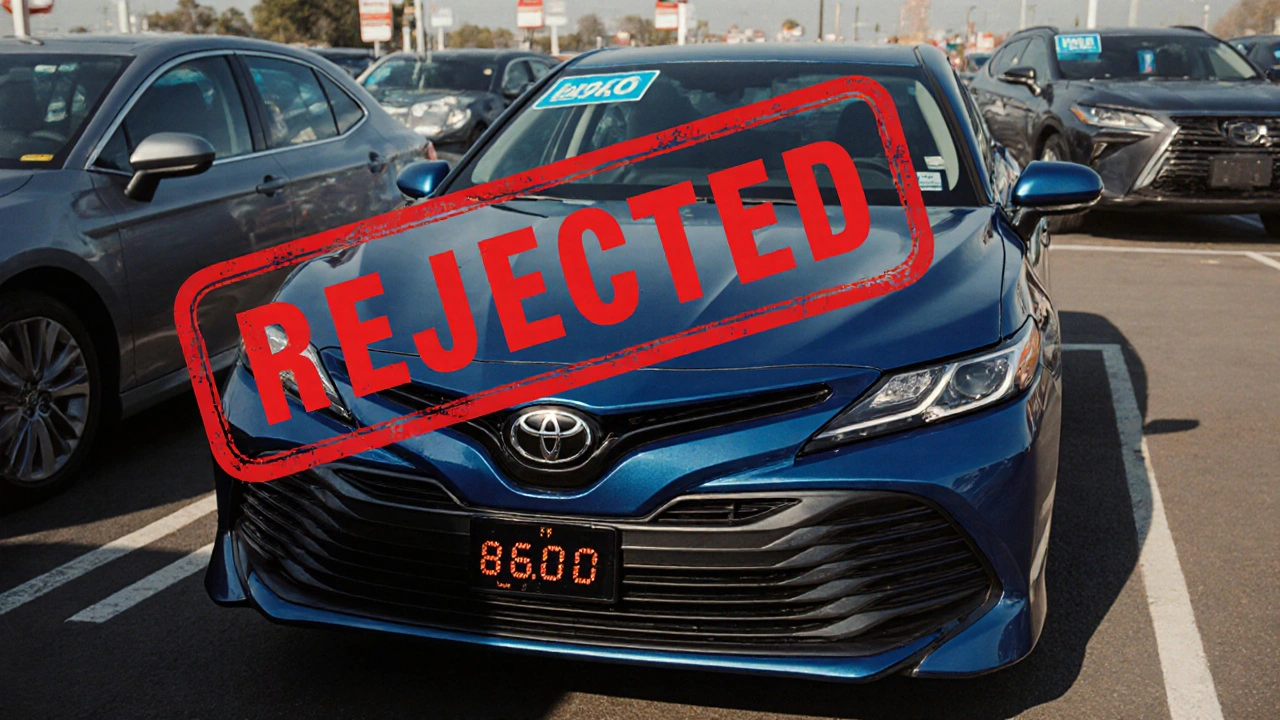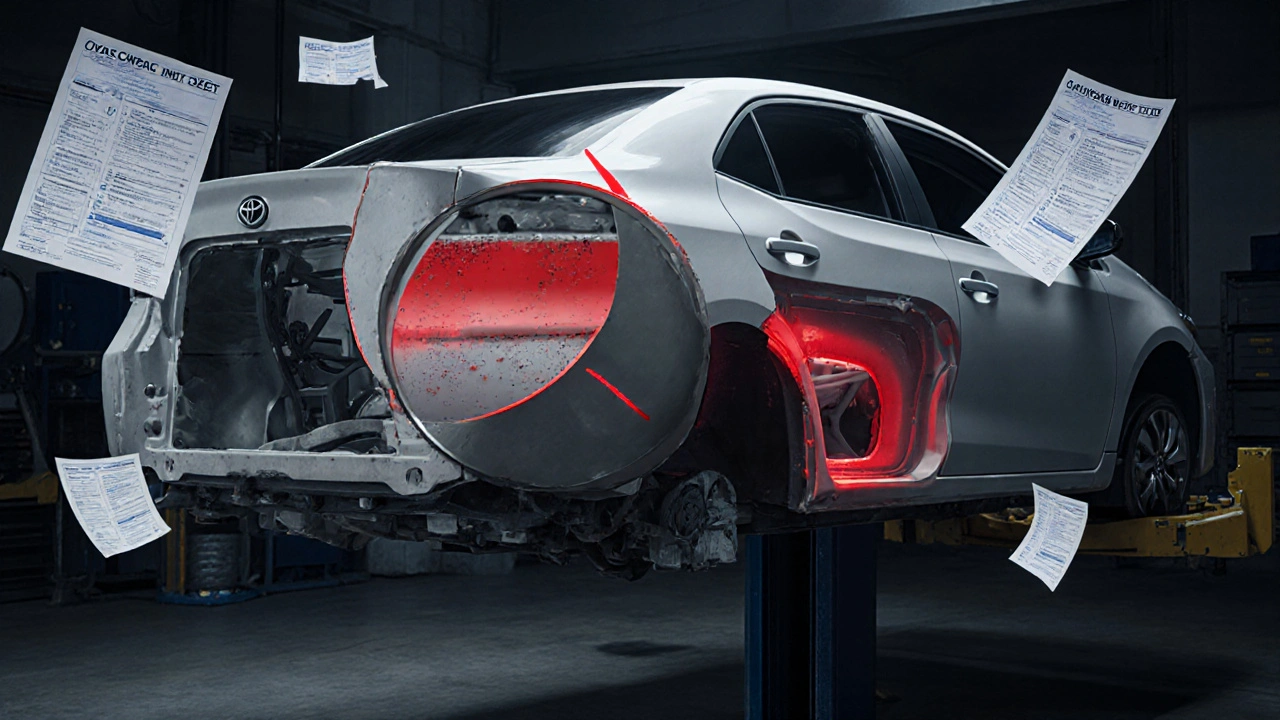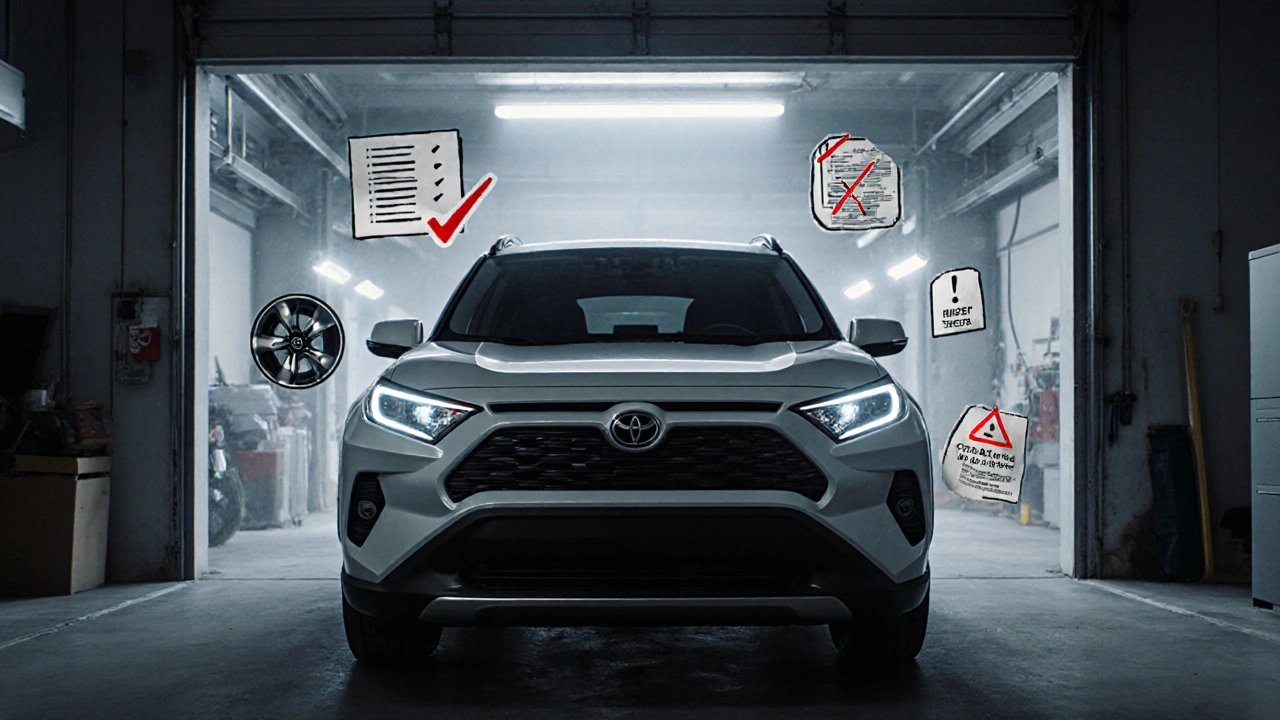Posted by Liana Harrow
10 Comments

Not every used Toyota makes it into a Certified Pre-Owned (CPO) program-even though Toyotas are known for reliability. If you’re shopping for a CPO Toyota and can’t find one that fits your budget, or you’re wondering why a specific car was turned down, the answer isn’t always about mileage or condition. There are strict rules, and Toyota doesn’t bend them. Here’s what actually keeps a Toyota from being certified.
Toyota’s CPO program only accepts vehicles that are six years old or newer and have fewer than 85,000 miles on the odometer. These numbers aren’t suggestions-they’re hard cutoffs. A 2018 Toyota Camry with 78,000 miles? Eligible. A 2018 Camry with 86,000 miles? Rejected. Even if the engine runs like new, the clock has run out.
Why these limits? CPO programs aren’t just about reliability-they’re about predictability. Toyota wants every certified car to have at least 12 months or 12,000 miles of warranty coverage left after purchase. If the car is too old or too high-mileage, the remaining warranty window shrinks too much to justify the cost of certification.
A car with a clean title doesn’t mean it’s accident-free. Toyota uses vehicle history reports from Carfax and AutoCheck to check for structural damage, frame bends, or airbag deployments. Even a minor fender bender that led to a repair in a critical area-like the unibody frame or suspension mounts-can trigger an automatic rejection.
One real example: a 2020 Corolla with only 42,000 miles and perfect service records was denied certification because the rear quarter panel had been replaced after a side-impact collision. The repair was done professionally, but Toyota’s inspection protocol flags any structural repair as a red flag. They don’t trust aftermarket repairs to meet factory standards, even if the owner has receipts.
Toyotas don’t need fancy maintenance to last 200,000 miles-but they do need consistent, documented care to qualify for CPO status. If the previous owner skipped oil changes, didn’t replace timing belts on schedule, or lost service records, the car won’t make the cut.
Toyota’s certification requires a full service history from a Toyota dealership or an authorized service provider. A receipt from a local mechanic saying “oil change performed” isn’t enough. The system needs to show the work was done with factory-approved parts and procedures. Missing even one major service-like a transmission fluid flush at 60,000 miles-can result in denial.
Some sellers try to clean up salvage titles or hide rebuild status. Toyota’s system catches this instantly. If a vehicle ever had a salvage title, even if it was later rebuilt and re-titled as “recovered,” it’s permanently ineligible for CPO.
Why? Because the structural integrity of the car can’t be guaranteed. Even if the car looks perfect and drives smoothly, the risk of hidden issues-like misaligned chassis, compromised safety systems, or water damage-is too high. Toyota won’t risk its reputation on a rebuilt car, no matter how well it was restored.

Custom wheels, lifted suspensions, aftermarket exhausts, or performance chips might make a Toyota stand out-but they also make it ineligible. Toyota’s CPO program requires the vehicle to be in original factory condition.
One buyer brought in a 2019 RAV4 with 55,000 miles and a full service history. It was rejected because the previous owner installed aftermarket LED headlights. The dealer’s technician flagged them as non-OEM and potentially unsafe under Toyota’s lighting standards. Even though the lights worked fine and were legal, the modification broke the certification rules. No exceptions.
Toyota has issued dozens of recalls over the years-for airbags, fuel pumps, brake systems, and more. A car with an open recall can’t be certified until every single recall campaign has been completed and verified by a Toyota dealership.
Some recalls are easy to miss. For example, the 2018-2020 Corolla had a recall for a faulty fuel pump that could cause stalling. If the previous owner ignored the recall notice, or the repair was done at a non-Toyota shop without proper documentation, the car stays off the CPO list. Dealerships run VIN checks automatically, and any unresolved recall means instant disqualification.
Many Toyotas on the used market come from lease returns. While some lease cars are perfect, others show signs of heavy use. Toyota CPO programs treat lease returns differently-they require a full inspection beyond the standard checklist.
Common issues that kill lease returns: excessive interior wear (stained seats, cracked dashboards), tire wear beyond 4/32”, or damage from pets or smoking. Even if the car has low mileage, if the interior shows signs of abuse, it’s rejected. Lease companies often return cars with minor damage that doesn’t affect function-but Toyota’s standards are about appearance and long-term durability, not just mechanics.

If your Toyota doesn’t qualify for CPO, you still have options. You can buy it as a regular used car-but you’ll lose the extended warranty, multi-point inspection, and roadside assistance that come with certification.
Some dealerships offer their own “pre-owned” warranties that aren’t Toyota-branded. These can be good, but they’re not the same. Toyota CPO includes a 7-year/100,000-mile powertrain warranty (from original in-service date), 24/7 roadside assistance, and a 160-point inspection done by factory-trained technicians. No third-party warranty matches that.
If you’re set on a non-certified Toyota, get a pre-purchase inspection from an independent mechanic who specializes in Toyotas. Look for signs of timing belt wear, transmission slippage, and suspension bushing degradation. These are the hidden issues that don’t show up in a basic scan.
Not every dealer labels a car as “certified” correctly. Always verify using Toyota’s official CPO portal. Enter the VIN at toyota.com/certified-yes, even if the dealer says it’s certified. The website will show you the exact warranty terms, inspection report, and whether the car is listed in Toyota’s database.
Real CPO Toyotas come with a blue CPO sticker on the driver’s side door jamb and a printed certification document. If you don’t see both, it’s not official.
A Toyota doesn’t get rejected because it’s unreliable. It gets rejected because it doesn’t meet a checklist. That checklist exists to protect buyers, not to make dealerships money. The same car that fails certification might still be a great buy-but you’re taking on more risk.
If you’re okay with that risk, go for it. Just know what you’re giving up: no factory-backed warranty, no guaranteed inspection, no roadside help. And if you ever need to sell it later, a non-certified Toyota will be harder to flip than one with the blue CPO badge.
No. Any vehicle that has ever had a salvage or rebuilt title is permanently ineligible for Toyota’s Certified Pre-Owned program. Even if the car was fully repaired and passed state inspections, Toyota’s policy does not allow exceptions for rebuilt titles due to concerns over structural integrity and long-term reliability.
Not always-but it often does. Toyota requires documented service history from a Toyota dealership or authorized service provider. If major services like timing belt replacement or transmission fluid flushes are missing, the car will be rejected. Minor missing records, like an oil change, might be overlooked if the vehicle has a strong overall history and passes inspection.
The Toyota CPO warranty includes a 12-month/12,000-mile limited warranty from the date of certification, plus a 7-year/100,000-mile powertrain warranty from the original in-service date. This means if your car is three years old with 40,000 miles when certified, you get up to four more years of powertrain coverage.
No. The 85,000-mile limit is absolute, regardless of warranty status. Even if the car is only four years old with 87,000 miles and a perfect service history, it won’t qualify. Toyota’s program is designed to include only low-mileage, late-model vehicles to ensure consistent quality across the certified inventory.
Yes. Any modification that changes factory specifications-like lift kits, performance chips, non-OEM wheels, or aftermarket lighting-automatically disqualifies a Toyota from CPO status. Even if the changes are legal and safe, Toyota requires the vehicle to be in original factory condition to ensure compatibility with their inspection and warranty standards.
Comments
adam smith
Wow. Just... wow. I had no idea Toyotas had it this strict. I thought if it ran fine, it was good enough. Guess I was wrong.
November 4, 2025 at 04:41
Mongezi Mkhwanazi
It’s not just strict-it’s obsessive. The fact that a single aftermarket LED headlight-functioning perfectly, legally installed, and clearly safer than the OEM unit-can disqualify a vehicle with 55,000 pristine miles and a full dealer service history… it’s not about safety, it’s about control. Toyota doesn’t trust the consumer. They don’t trust independent mechanics. They don’t even trust the car itself if it’s been modified in any way that deviates from the factory blueprint. And yet, they wonder why people buy Hondas or even used Teslas instead.
November 4, 2025 at 13:40
Mark Nitka
I get why they do it-certification is a promise. But the way they treat lease returns is insane. Stained seats? Cracked dash? That’s wear and tear, not a defect. If the engine’s solid and the frame’s untouched, why penalize the buyer for someone else’s coffee spills? I’ve bought non-CPO Toyotas with 120k miles and they’ve outlasted three CPO Hondas. The system’s rigid, not smart.
November 4, 2025 at 20:43
Kelley Nelson
It is rather disheartening, isn't it? The sheer performative nature of these certification standards-whereby a vehicle’s worth is determined not by its mechanical integrity, but by its adherence to an arbitrary, corporate-sanctioned checklist-is emblematic of a broader cultural malaise. One is left to wonder whether the pursuit of ‘certified’ status has become less about consumer protection and more about brand sanctimony. The blue sticker, after all, is a sacrament, not a service.
November 4, 2025 at 20:48
Aryan Gupta
Let me tell you something… they’re hiding something. Why do they reject rebuilt titles? Because they know the factories used to cut corners on repairs after major accidents. The same people who say ‘Toyota reliability’ are the same ones who covered up airbag defects and faulty fuel pumps. You think they care about your safety? No. They care about liability. That’s why they won’t certify anything with a repair history-even if it’s better than new. They’re scared of lawsuits. And you? You’re just a number in their database.
November 5, 2025 at 03:33
Fredda Freyer
There’s a deeper truth here: Toyota’s CPO program isn’t about cars-it’s about trust. People buy Toyotas because they believe they’ll last. The certification rules are designed to preserve that myth. But here’s the thing-reliability isn’t about paperwork. It’s about how the car behaves over time. I’ve seen non-CPO Toyotas with missing service records run for 300k miles because the owner just changed oil every 5k and didn’t panic. Meanwhile, a CPO car with perfect records can still have a cracked timing belt because someone skipped the 100k service. The system rewards compliance, not competence. And that’s the real flaw.
November 6, 2025 at 19:00
Gareth Hobbs
Blimey, this is what happens when Yanks turn everything into a bureaucratic nightmare. Back in the UK, we’d just look under the bonnet, give it a shake, and if it didn’t fall apart, we’d buy it. Now? You need a PhD in Toyota compliance just to buy a Corolla. And don’t get me started on those ‘non-OEM’ headlights-some bloke put in LEDs because the stock ones were dim as a candle in a hurricane. Now it’s ‘un-certified’? Madness. This isn’t quality control-it’s corporate overreach. And don’t tell me it’s for safety-my 2004 Avensis had more miles than your entire dealership inventory and never missed a beat.
November 7, 2025 at 07:06
Zelda Breach
Let’s be real: if you’re buying a non-CPO Toyota, you’re not saving money-you’re gambling with your life. That ‘perfect’ 2018 Camry with 87k miles? It’s got a hidden frame bend from a rear-end collision that the seller didn’t mention. That ‘clean’ service history? The oil change was done with synthetic blend, not full synthetic, and the timing belt’s 20k miles overdue. You think you’re getting a deal? You’re getting a death trap with a warranty voided by a missing receipt. Don’t be a fool.
November 7, 2025 at 16:21
Alan Crierie
Hey everyone-just wanted to say I really appreciate how thoughtful this post is. It’s easy to get frustrated when you’re denied CPO status, but the reasons here make total sense. I used to think aftermarket parts were cool, but now I see why Toyota wants everything stock-it’s not about control, it’s about making sure every single part works together perfectly. I’ve had a 2017 Prius for 8 years now, and I’ve never touched the suspension or lights. I just keep up with the oil changes and it’s been a dream. If you’re reading this and thinking about modifying your car… maybe just enjoy it as it is? 😊
November 7, 2025 at 21:16
Nicholas Zeitler
Biggest tip: If you’re eyeing a non-CPO Toyota, get a pre-purchase inspection from a Toyota specialist-NOT a general mechanic. They know the weak spots: timing chain tensioners on 2014+ engines, rear suspension bushings on RAV4s, and transmission fluid leaks on 2016-2019 Corollas. Also-always check the VIN on toyota.com/certified. I’ve seen dealers slap ‘Certified’ on cars that weren’t. Don’t trust the sticker. Trust the database. You’ll thank yourself later.
November 8, 2025 at 16:22